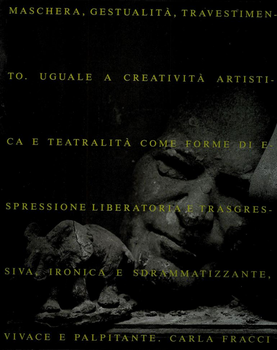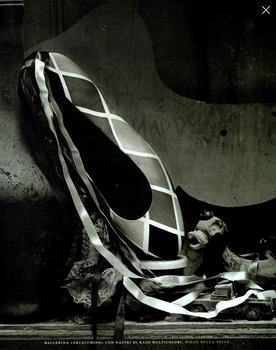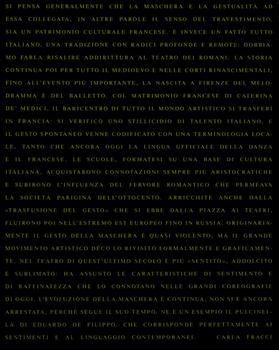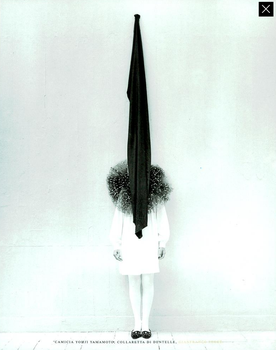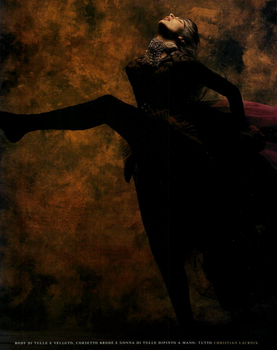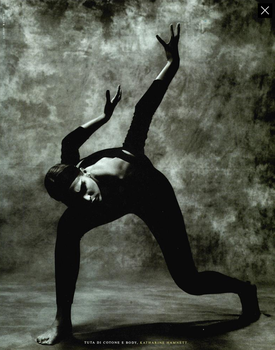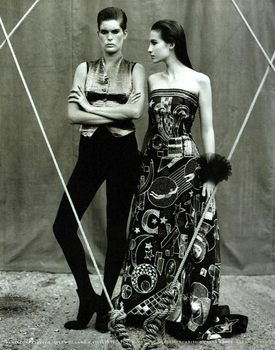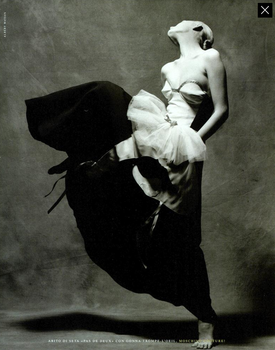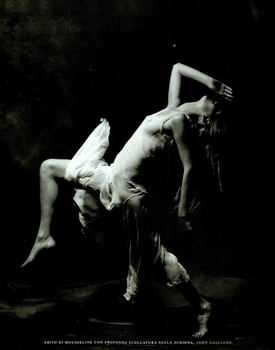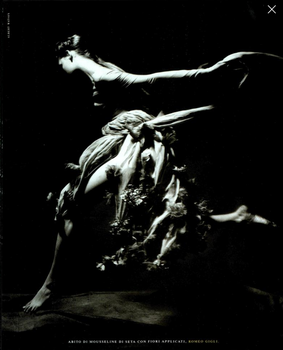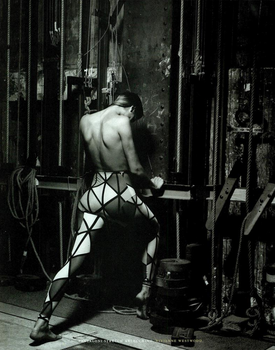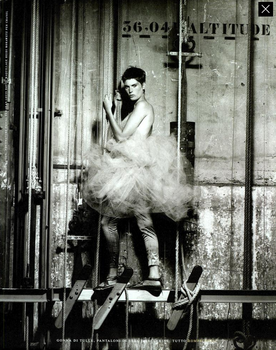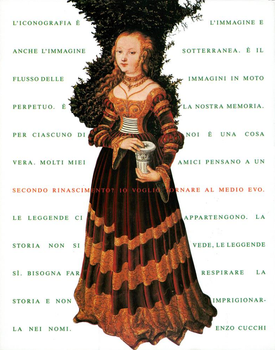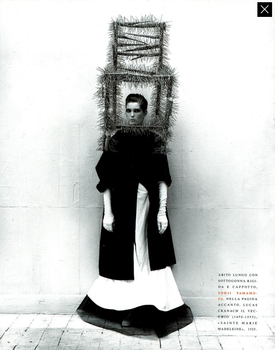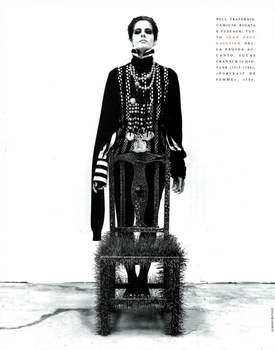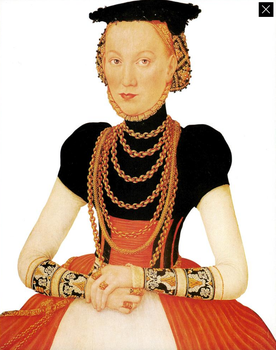- Joined
- Jul 24, 2010
- Messages
- 92,525
- Reaction score
- 61,447
CR Fashion Book
A magazine of style & inspiration by Carine Roitfeld
ARCHIVE RANDOM RSS

LESLIE WINER
The radical life of an enduring fashion muse, renegade musician, and perpetual badass
The first androgynous fashion model Leslie Winer is the definition of an original. But she has so much more than glossy pictures to her name, like a longstanding experimental music career and first-hand tales of counterculture icons from Burroughs to Basquiat. On the eve of a retrospective album, she spares nothing and no one when reflecting on the past.
Above: Photography Jean-Baptiste Mondino

Above: Still from Mekon’s music video for “Calm Gunshot,” featuring Leslie Winer, directed by John Maybury and Honey Brothers. Courtesy Wall of Sound

Above: Cover of Leslie Winer’s Witch (1993)
Grandmother of trip-hop, former punk model, dub lesbian, witch… Leslie Winer has been called many things over the course of her 25-year music career. But the latter of these labels is the one she wears as a badge of honor. “Witch” was the title of her influential debut album, whose deadpan feminist musings are as relevant today as they ever were: “because a woman’s work is never done, and underpaid, boring, and repetitious. And I’m the first one to get the sack.”
Witch appeared under the name ©, the circle of the copyright symbol formed by a serpent biting its own tail. “I was thinking about intellectual property as a concept and the general freakiness of the notion of owning words,” Winer says today. The album’s packaging was notable for its lack of any images depicting her. As one of her lyrics—“what I look like is more important than what I do”—laments, she was tired of being photographed.
In the preceding decade, she had been portrayed by everyone from Helmut Newton and Jean-Baptiste Mondino to Pierre et Gilles and Tony Viramontes, and had appeared on the cover of every magazine from Mademoiselle and The Face to French and Italian Vogue. Her TV campaign for Miss Dior and a two-year stint as the Valentino girl had left her feeling nothing but contempt for the fashion industry. “I was a reluctant model for five junkie years,” she says. “Didn’t like it then. Don’t like it now. Somehow, thanks to the magic of fashion revisionism, I have been upgraded to former supermodel. What the **** is that? That concept didn’t even exist then. I’m also a former nasty alcoholic and former Tampax user, each for more than five years and with considerably more enthusiasm.”
Occasioned by the forthcoming publication of her first volume of poems, the release of a retrospective compilation CD, and a digital re-release of Witch, Winer opens up about then and now.
THERE’S NO MEANING IN THESE WORDS
The joy of reading was instilled in Winer at an early age, by her adoptive grandmother. “She was the love of my life,” she says. “When I was a little kid she’d have me memorize poems. I read everything I possibly could. It was a refuge for me.” In the late ’70s, Winer fled her “creepy suburban life” in Weston, Massachusetts, and headed to New York to take conceptual art pioneer Joseph Kosuth’s course at the School of Visual Arts. To make money for materials, she helped her neighbor, Stewart Meyer, write and proofread p*rn novels. “He worked for these two Italian guys,” Winer remembers. “They had a very strict set of rules: no male homosexuality, plenty of lesbianism, no bestiality. The level of stuff they wanted was like, ‘Her huge, milky white globes jiggled like a Thanksgiving Day Jell-O platter as she bounced on his humongous meat pole.’”
Meyer’s bookshelves furnished Winer with a crash course in Beat literature, and he introduced her to luminaries William S. Burroughs and Herbert Huncke. “I used to take Burroughs blueberries and sour cream. He’d read me the newspaper, we’d build model helicopters and do target practice, or I’d sit in the orgone accumulator. He made me read Denton Welch, The Tibetan Book of the Dead, and Wallis Budge. Huncke’s methadone clinic was close to my house, so he would drop by two or three times a week. He was born in Greenfield, Massachusetts, near where I was born, and would tell me stories about his childhood. When I would have to go out to the store or something, he’d say, ‘You can’t leave me alone Leeesleee, have I taught you nothing? I’ll steal everything the minute you’re gone.’ Burroughs was like a grandfather figure for me. There was a kind of formality to our relationship. He was a classicist, whereas Huncke was a romantic.”
After years of jetting between photo shoots in New York, Paris, Milan, and Tokyo—where her bad behavior got her banned from every nightclub—the mid 1980s found Winer at the epicenter of London’s demimonde, sharing a flat with underground filmmaker John Maybury and his boyfriend, Trojan, painter of faux-naïf Day-Glo fantasies, set designer for choreographer Michael Clark, and permanent fixture at Leigh Bowery’s notorious club, Taboo. It was in this hedonistic milieu that she met Kevin Mooney, a hell-raiser who had played bass with Adam and the Ants but jumped ship in 1981, just as the band was shedding its raw punk aesthetic for a more slick, chart-friendly, new-romantic sound. He then fronted the short-lived Wide Boy Awake before teaming up with childhood friend John Keogh to form Max, for which Winer provided lyrics and visual direction.
vimeo.com/48170685
CM von Hausswolff & Leslie Winer - I’ll Be Mother from Eye tOy /Sébastien Chou on Vimeo.
Trojan and Maybury were the sole witnesses at Winer and Mooney’s shotgun wedding in the spring of 1986. “I got married for the papers,” Winer says. “Period. The British wanted me to leave the country.” A few months later, Trojan was dead, at age 21, from an accidental overdose. Max paid tribute to his incorrigible flamboyance in its 1987 release “Little Ghost,” penned by Winer and Mooney: “Here is an angel with a bow and arrow, saying God doesn’t know how to put on her halo.” The B-side featured Winer’s debut vocal performance, on the track “337.5537’s Little Ghost.” The mysterious title alluded to her early ’80s romance with painter Jean-Michel Basquiat. “I lived with him mostly off and sometimes on for a couple of years,” says Winer. “3375537 is my name upside-down, calculator-wise, phone-number length. Basquiat used it for tagging. Dondi White and Rammellzee would use it as far north as the Bronx as what I like to call a ‘fat-girl nod’ in my direction.”
Winer and Mooney next wrote “Just Call Me Joe” for Sinéad O’Connor, with Winer intoning her own dystopian prose at the close of the track. Watching legendary producer Trevor Horn work on Max’s album gave her the confidence to branch out on her own and take a new artistic direction. “I wasn’t pleased with the way Max was making its music. I was that annoying kind of studio back-seat driver. But watching Trevor mix I could see he was doing the whole thing visually, like choreographing in space, and I realized I could try that.”
In 1988, Winer recorded her first song, “Kind of Easy,” with Karl Bonnie from Renegade Soundwave. “That was the first time I got to put down music how I wanted,” she says. “We sent it to Jon Baker at Gee Street, who put us in the studio. He hated the tracks we came up with, but wouldn’t give us the tapes. Karl broke in and stole them back, and we took them to Rhythm King, who put ‘Kind of Easy’ out on vinyl. This must have been in 1989 or 1990. Karl’s brother told us it was a popular cassette bootleg among bicycle messengers in London, and we were way-out-of-proportion pleased with ourselves.” The subsequent white-label pressing of Witch, with its combination of sluggish reggae beats, lo-fi samples, spacey reverb, and spoken-word vocal delivery provided a blueprint for the trip-hop sound popularized over the next few years by Massive Attack, Tricky, and Portishead. By the time Witch had its official release, in 1993, it was old news for Winer. She had moved on, both artistically and geographically.
THESE ARE THE WORDS I DIDN’T INVENT. ONLY AN ATTEMPT TO SAY WHAT I MEANT.
In 1991, Winer relocated to Miami and was working at Island Records founder Chris Blackwell’s South Beach Studios, run by Cuban-American producer Joe Galdo, inventor of the Miami Sound. The material she recorded there, 3 Bags Full and Spider, has slowly percolated to the surface over the last decade or so in almost impossible-to-find limited editions. In 1999, longtime friend and fan Helmut Lang issued Spider as a CD, limited to 500 copies, and in 2010, London-based cassette-only label The Tapeworm released tracks from both projects under the title & That Dead Horse, in an edition of 250. “This is Life,” one of the songs Winer wrote for Grace Jones’s shelved Black Marilyn album, finally appeared (albeit in slightly adulterated form) as the opening track on Jones’s 2008 comeback album, Hurricane. Last year saw the release of a four-track vinyl EP, Always Already, under the name Purity Supreme, Winer’s ongoing artistic partnership with French musician and producer Christophe Van Huffel. Meanwhile, Winer’s association with The Tapeworm has spawned as-yet-unfinished collaborations with artists as diverse as Swedish composer Carl Michael von Hausswolff (King of Elgaland-Vargaland), and London-based ecstatic noise artist Dale Cornish. And there’s a forthcoming Bookworm edition, 10 Pomes Fin (Irish Wristwatch).
& WORDS I HAVE NONE. I JUST STEEL THEM & MAKE THEM TALK.
Close listening to Winer’s songs over the past 25 years reveals her recycling certain lyrics, rephrased from track to track to create shifting constellations of meaning. “When I was pregnant with my second daughter,” Winer recalls, “I joined a Heidegger study group at MIT because I figured it would make the baby much smarter. They were unpacking his book Poetry, Language, Thought, which contains a Rilke fragment: ‘…in the end, it is our unshieldedness on which we depend, and that, when we saw it threaten, we turned it so into the Open that, in widest orbit somewhere, where the Law touches us, we may affirm it.’ I’ve been parsing that over and over for 25 years to get at its it-ness, its suchness. I’ll get hold of a sentence and live my way into understanding it. It’s a private business. It’s not like, I’m gonna make something and people will like it. It’s a selfish pleasure.”
Words Gerard Forde
crfashionbook.tumblrA magazine of style & inspiration by Carine Roitfeld
ARCHIVE RANDOM RSS

LESLIE WINER
The radical life of an enduring fashion muse, renegade musician, and perpetual badass
The first androgynous fashion model Leslie Winer is the definition of an original. But she has so much more than glossy pictures to her name, like a longstanding experimental music career and first-hand tales of counterculture icons from Burroughs to Basquiat. On the eve of a retrospective album, she spares nothing and no one when reflecting on the past.
Above: Photography Jean-Baptiste Mondino

Above: Still from Mekon’s music video for “Calm Gunshot,” featuring Leslie Winer, directed by John Maybury and Honey Brothers. Courtesy Wall of Sound

Above: Cover of Leslie Winer’s Witch (1993)
Grandmother of trip-hop, former punk model, dub lesbian, witch… Leslie Winer has been called many things over the course of her 25-year music career. But the latter of these labels is the one she wears as a badge of honor. “Witch” was the title of her influential debut album, whose deadpan feminist musings are as relevant today as they ever were: “because a woman’s work is never done, and underpaid, boring, and repetitious. And I’m the first one to get the sack.”
Witch appeared under the name ©, the circle of the copyright symbol formed by a serpent biting its own tail. “I was thinking about intellectual property as a concept and the general freakiness of the notion of owning words,” Winer says today. The album’s packaging was notable for its lack of any images depicting her. As one of her lyrics—“what I look like is more important than what I do”—laments, she was tired of being photographed.
In the preceding decade, she had been portrayed by everyone from Helmut Newton and Jean-Baptiste Mondino to Pierre et Gilles and Tony Viramontes, and had appeared on the cover of every magazine from Mademoiselle and The Face to French and Italian Vogue. Her TV campaign for Miss Dior and a two-year stint as the Valentino girl had left her feeling nothing but contempt for the fashion industry. “I was a reluctant model for five junkie years,” she says. “Didn’t like it then. Don’t like it now. Somehow, thanks to the magic of fashion revisionism, I have been upgraded to former supermodel. What the **** is that? That concept didn’t even exist then. I’m also a former nasty alcoholic and former Tampax user, each for more than five years and with considerably more enthusiasm.”
Occasioned by the forthcoming publication of her first volume of poems, the release of a retrospective compilation CD, and a digital re-release of Witch, Winer opens up about then and now.
THERE’S NO MEANING IN THESE WORDS
The joy of reading was instilled in Winer at an early age, by her adoptive grandmother. “She was the love of my life,” she says. “When I was a little kid she’d have me memorize poems. I read everything I possibly could. It was a refuge for me.” In the late ’70s, Winer fled her “creepy suburban life” in Weston, Massachusetts, and headed to New York to take conceptual art pioneer Joseph Kosuth’s course at the School of Visual Arts. To make money for materials, she helped her neighbor, Stewart Meyer, write and proofread p*rn novels. “He worked for these two Italian guys,” Winer remembers. “They had a very strict set of rules: no male homosexuality, plenty of lesbianism, no bestiality. The level of stuff they wanted was like, ‘Her huge, milky white globes jiggled like a Thanksgiving Day Jell-O platter as she bounced on his humongous meat pole.’”
Meyer’s bookshelves furnished Winer with a crash course in Beat literature, and he introduced her to luminaries William S. Burroughs and Herbert Huncke. “I used to take Burroughs blueberries and sour cream. He’d read me the newspaper, we’d build model helicopters and do target practice, or I’d sit in the orgone accumulator. He made me read Denton Welch, The Tibetan Book of the Dead, and Wallis Budge. Huncke’s methadone clinic was close to my house, so he would drop by two or three times a week. He was born in Greenfield, Massachusetts, near where I was born, and would tell me stories about his childhood. When I would have to go out to the store or something, he’d say, ‘You can’t leave me alone Leeesleee, have I taught you nothing? I’ll steal everything the minute you’re gone.’ Burroughs was like a grandfather figure for me. There was a kind of formality to our relationship. He was a classicist, whereas Huncke was a romantic.”
After years of jetting between photo shoots in New York, Paris, Milan, and Tokyo—where her bad behavior got her banned from every nightclub—the mid 1980s found Winer at the epicenter of London’s demimonde, sharing a flat with underground filmmaker John Maybury and his boyfriend, Trojan, painter of faux-naïf Day-Glo fantasies, set designer for choreographer Michael Clark, and permanent fixture at Leigh Bowery’s notorious club, Taboo. It was in this hedonistic milieu that she met Kevin Mooney, a hell-raiser who had played bass with Adam and the Ants but jumped ship in 1981, just as the band was shedding its raw punk aesthetic for a more slick, chart-friendly, new-romantic sound. He then fronted the short-lived Wide Boy Awake before teaming up with childhood friend John Keogh to form Max, for which Winer provided lyrics and visual direction.
vimeo.com/48170685
CM von Hausswolff & Leslie Winer - I’ll Be Mother from Eye tOy /Sébastien Chou on Vimeo.
Trojan and Maybury were the sole witnesses at Winer and Mooney’s shotgun wedding in the spring of 1986. “I got married for the papers,” Winer says. “Period. The British wanted me to leave the country.” A few months later, Trojan was dead, at age 21, from an accidental overdose. Max paid tribute to his incorrigible flamboyance in its 1987 release “Little Ghost,” penned by Winer and Mooney: “Here is an angel with a bow and arrow, saying God doesn’t know how to put on her halo.” The B-side featured Winer’s debut vocal performance, on the track “337.5537’s Little Ghost.” The mysterious title alluded to her early ’80s romance with painter Jean-Michel Basquiat. “I lived with him mostly off and sometimes on for a couple of years,” says Winer. “3375537 is my name upside-down, calculator-wise, phone-number length. Basquiat used it for tagging. Dondi White and Rammellzee would use it as far north as the Bronx as what I like to call a ‘fat-girl nod’ in my direction.”
Winer and Mooney next wrote “Just Call Me Joe” for Sinéad O’Connor, with Winer intoning her own dystopian prose at the close of the track. Watching legendary producer Trevor Horn work on Max’s album gave her the confidence to branch out on her own and take a new artistic direction. “I wasn’t pleased with the way Max was making its music. I was that annoying kind of studio back-seat driver. But watching Trevor mix I could see he was doing the whole thing visually, like choreographing in space, and I realized I could try that.”
In 1988, Winer recorded her first song, “Kind of Easy,” with Karl Bonnie from Renegade Soundwave. “That was the first time I got to put down music how I wanted,” she says. “We sent it to Jon Baker at Gee Street, who put us in the studio. He hated the tracks we came up with, but wouldn’t give us the tapes. Karl broke in and stole them back, and we took them to Rhythm King, who put ‘Kind of Easy’ out on vinyl. This must have been in 1989 or 1990. Karl’s brother told us it was a popular cassette bootleg among bicycle messengers in London, and we were way-out-of-proportion pleased with ourselves.” The subsequent white-label pressing of Witch, with its combination of sluggish reggae beats, lo-fi samples, spacey reverb, and spoken-word vocal delivery provided a blueprint for the trip-hop sound popularized over the next few years by Massive Attack, Tricky, and Portishead. By the time Witch had its official release, in 1993, it was old news for Winer. She had moved on, both artistically and geographically.
THESE ARE THE WORDS I DIDN’T INVENT. ONLY AN ATTEMPT TO SAY WHAT I MEANT.
In 1991, Winer relocated to Miami and was working at Island Records founder Chris Blackwell’s South Beach Studios, run by Cuban-American producer Joe Galdo, inventor of the Miami Sound. The material she recorded there, 3 Bags Full and Spider, has slowly percolated to the surface over the last decade or so in almost impossible-to-find limited editions. In 1999, longtime friend and fan Helmut Lang issued Spider as a CD, limited to 500 copies, and in 2010, London-based cassette-only label The Tapeworm released tracks from both projects under the title & That Dead Horse, in an edition of 250. “This is Life,” one of the songs Winer wrote for Grace Jones’s shelved Black Marilyn album, finally appeared (albeit in slightly adulterated form) as the opening track on Jones’s 2008 comeback album, Hurricane. Last year saw the release of a four-track vinyl EP, Always Already, under the name Purity Supreme, Winer’s ongoing artistic partnership with French musician and producer Christophe Van Huffel. Meanwhile, Winer’s association with The Tapeworm has spawned as-yet-unfinished collaborations with artists as diverse as Swedish composer Carl Michael von Hausswolff (King of Elgaland-Vargaland), and London-based ecstatic noise artist Dale Cornish. And there’s a forthcoming Bookworm edition, 10 Pomes Fin (Irish Wristwatch).
& WORDS I HAVE NONE. I JUST STEEL THEM & MAKE THEM TALK.
Close listening to Winer’s songs over the past 25 years reveals her recycling certain lyrics, rephrased from track to track to create shifting constellations of meaning. “When I was pregnant with my second daughter,” Winer recalls, “I joined a Heidegger study group at MIT because I figured it would make the baby much smarter. They were unpacking his book Poetry, Language, Thought, which contains a Rilke fragment: ‘…in the end, it is our unshieldedness on which we depend, and that, when we saw it threaten, we turned it so into the Open that, in widest orbit somewhere, where the Law touches us, we may affirm it.’ I’ve been parsing that over and over for 25 years to get at its it-ness, its suchness. I’ll get hold of a sentence and live my way into understanding it. It’s a private business. It’s not like, I’m gonna make something and people will like it. It’s a selfish pleasure.”
Words Gerard Forde





















